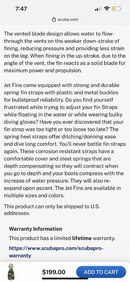I'm not a physicist, so forgive me if I won't go into the science of fin blade venting. I recommend reading one of Beuchat's Jetfin patents, e.g.
GB1223664.
Forgive me too if I just copy over here some text and images from another thread to save time.
I'm old enough to have been around in the early 1960s when the original Beuchat Jetfin first came out. The model was described in French as a "palme à tuyères" ("fin with jets" or "jetted fin" in English) and given the product name "Jetfin" as a single word. Here is an early flyer in French about the fin's mechanics:
Note how the fin was first conceived in the early 1960s as a full-foot fin because "palmes chaussantes" were considered to be the design of choice at the time for serious divers in Europe. Closed-heel fins back then were much more expensive than open-heel ones. As you have discovered, however, Beuchat did produce an open-heel version of the Jetfin to fit bigger foot sizes and Scubapro stuck to open-heels when the American company sold Jet Fins (two-word spelling) States-side.
Beuchat produced an open-toe version of the Jetfin in the late 1960s and early to mid 1970s. This version appeared in Beuchat's French (
Dispositif d'accélération de poussée pour palme de natation) and British (
Improvements in or relating to swim-fins) patents of 1971. The British patent drawings below:
And here is a picture of a pair of closed-heel and open-toed Jetfins:
However, the story doesn't finish there. Here's a 1969 Jetfin ad from the wonderful bibliotecadiunapneista.it site:
Note how this version has two jets instead of the usual three through the blade.
And there's more still. Here's a version with a closed heel, an open toe and the buckle points for a heel strap:
And here's another closed-heel with heelstrap version with a closed toe. Note the different blades:
It would appear that Beuchat developed many full-foot Jetfin designs, realising perhaps that Scubapro had no intention of releasing a closed-heel version of Scubapro Jet Fins and that Beuchat could therefore continue making and selling their own Jetfins in a variety of versions for the European market.
And to avoid disappointing the fans of open-heel Jetfins, here's a couple of pictures:
I read somewhere that the largest size Jetfins were open-heel because a closed-heel version would have cost too much. During the 1960s and 1970s, the full-foot fin was king in continental Europe.






 Pull up a seat boys and girls, this is going to be good!
Pull up a seat boys and girls, this is going to be good!